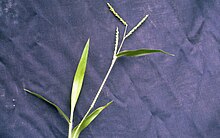Urochloa panicoides: Difference between revisions
m Removing from Category:Invasive plant species in the United States see category description using Cat-a-lot |
Add IUCN status and reference |
||
| (4 intermediate revisions by 4 users not shown) | |||
| Line 1: | Line 1: | ||
{{Short description|Species of grass}} |
|||
{{Speciesbox |
{{Speciesbox |
||
|image = Urochloa panicoides.jpg |
|image = Urochloa panicoides.jpg |
||
|status = LC |
|||
|status_system = IUCN3.1 |
|||
|status_ref = <ref name=IUCN>{{cite iucn | author = Mani, S. | title = ''Urochloa panicoides'' | page = e.T177192A17669796 | year = 2013 | access-date = 30 May 2022}}</ref> |
|||
|genus = Urochloa |
|genus = Urochloa |
||
|species = panicoides |
|species = panicoides |
||
| Line 29: | Line 33: | ||
==Common names== |
==Common names== |
||
Common names for the grass include '''''barajalgauti''''', '''''basaunta''''' ([[Punjabi language|Punjabi]]), '''''tuinheesgras''''', '''''heesgras''''', '''''kurimanna''''' ([[Afrikaans]]), '''sharp-flowered signal-grass''',<ref name=BSBI07>{{ |
Common names for the grass include '''''barajalgauti''''', '''''basaunta''''' ([[Punjabi language|Punjabi]]), '''''tuinheesgras''''', '''''heesgras''''', '''''kurimanna''''' ([[Afrikaans]]), '''sharp-flowered signal-grass''',<ref name=BSBI07>{{BSBI 2007 |access-date=2014-10-17 }}</ref> '''annual signal grass''', '''garden signal grass''', '''panic liverseed grass''', '''herringbone grass''' ([[English language|English]]), '''kuri millet''' (in [[Zimbabwe]]), '''''pasto africano''''' ([[Italian language|Italian]]), '''''farsho''''' ([[Somali language|Somali]]), '''''kgolane''''', and '''''bore-ba-ntjia''''' ([[Sotho language|Sotho]]). |
||
==References== |
==References== |
||
| Line 38: | Line 42: | ||
[[Category:Panicoideae]] |
[[Category:Panicoideae]] |
||
[[Category:Grasses of Africa]] |
[[Category:Grasses of Africa]] |
||
[[Category:Flora of the Arabian Peninsula]] |
|||
[[Category:Flora of Iran]] |
|||
[[Category:Flora of the Indian subcontinent]] |
|||
[[Category:Taxa named by Palisot de Beauvois]] |
[[Category:Taxa named by Palisot de Beauvois]] |
||
Latest revision as of 03:25, 30 May 2022
| Urochloa panicoides | |
|---|---|

| |
| Scientific classification | |
| Kingdom: | Plantae |
| Clade: | Tracheophytes |
| Clade: | Angiosperms |
| Clade: | Monocots |
| Clade: | Commelinids |
| Order: | Poales |
| Family: | Poaceae |
| Subfamily: | Panicoideae |
| Genus: | Urochloa |
| Species: | U. panicoides
|
| Binomial name | |
| Urochloa panicoides | |
| Synonyms | |
|
Panicum borzianum | |
Urochloa panicoides is a fodder grass originating in Southern Africa.
Description[edit]
This annual grass has decumbent or upright stems up to a meter long. It may root where its lower nodes contact the substrate. The leaves have linear or lance-shaped blades up to 25 centimeters long. They are hairless to somewhat hairy, and they may have hairs lining the edges. The inflorescence is composed of up to 10 racemes, each up to 7 centimeters long. The spikelets are solitary or paired.[2]
Urochloa panicoides can be confused with Urochloa setigera, but the morphology of the spikelet is slightly different.
Distribution[edit]
This grass is native to southern Africa. It has naturalized elsewhere, including Australia, Argentina, India and the United States.[citation needed]
Ecology[edit]
It is most common on moist grasslands and lakesides up to an altitude of 2200 meters.
Usage[edit]
This grass is often used as a fodder for cattle and horses. It is now known as a weed and a potential seed contaminant.
Diseases and pests[edit]
This grass is susceptible to the maize streak virus (MSV), which is transmitted by Cicadulina leafhoppers such as Cicadulina mbila, C. arachidis, C. triangula, C. bimaculata, C. similis, C. latens, C ghaurii, and C. parazeae.
It is also susceptible to cereal chlorotic mottle virus, which is transmitted by several insects, including Nesoclutha pallida and Cicadula bimaculata.
Common names[edit]
Common names for the grass include barajalgauti, basaunta (Punjabi), tuinheesgras, heesgras, kurimanna (Afrikaans), sharp-flowered signal-grass,[3] annual signal grass, garden signal grass, panic liverseed grass, herringbone grass (English), kuri millet (in Zimbabwe), pasto africano (Italian), farsho (Somali), kgolane, and bore-ba-ntjia (Sotho).
References[edit]
- ^ Mani, S. (2013). "Urochloa panicoides". IUCN Red List of Threatened Species. 2013: e.T177192A17669796. Retrieved 30 May 2022.
- ^ Clayton, W.D.; Vorontsova, M.S.; Harman, K.T.; Williamson, H. "Urochloa panicoides". GrassBase - The Online World Grass Flora. Royal Botanic Gardens, Kew.
- ^ BSBI List 2007 (xls). Botanical Society of Britain and Ireland. Archived from the original (xls) on 2015-06-26. Retrieved 2014-10-17.

